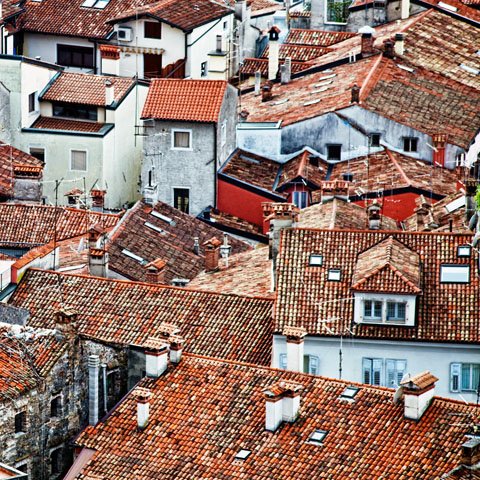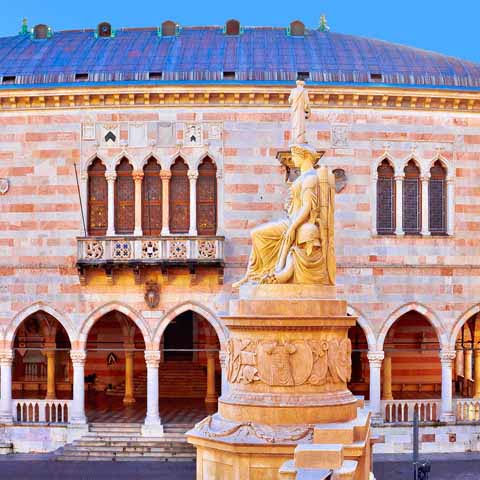On the very edge of Italy’s far northeast corner is the beautiful border city of Gorizia, which serves as a frontier between the Latin and Slavic worlds. Most locals speak both Italian and Slovenian, and border locations within the city feature signs in both languages. This quiet and unassuming town is simply beautiful, with picturesque city squares and gardens galore. Gorizia is a balm for the weary soul and a peaceful respite from the hustle and bustle of some larger Italian destinations.
Gorizia is located in the region of Friuli Venezia Giulia and was once the capital of the province of Gorizia. At eighty-four miles above sea level at the foot of the Julian Alps, the city is rather small with an area of only around sixteen square miles and a population of just over thirty thousand.
But what Gorizia lacks in size, it makes up for in character. The city proper is quite stunning, with immaculate buildings of Austrian influenced architecture lining the sides of the main thoroughfares. Here you will find beautiful shops and quaint cafes frequented by locals and visitors alike. Despite these beautiful buildings and structures, many refer to Gorizia as the “Garden City” due to the abundance of public and private gardens that seamlessly fit into the architecture and layout of the city.
Despite the somewhat rural outskirts of the town, Gorizia is an industrial city and offers multiple educational opportunities. The city’s main industries include the manufacturing of textiles, leather goods, paper, building materials, furniture, and food. Educational opportunities abound at the University of Nova Gorica, the University of Udine, and the University of Trieste, all of which have a branch or facility in Gorizia.
If traveling to Gorizia today, most of its visitors would probably be surprised to hear of the city’s unique history. The town began long ago as a small village. The first documentation of the city’s existence traces back to the beginning of the eleventh century. From that point on, Gorizia experienced a turbulent history under the reign of several different rulers. During the fifteenth century, the remaining heirs of the Count of Gorizia passed away and the city’s future was hotly disputed by Venice and the Austrian Empire.
After World War I, Gorizia became a part of the Kingdom of Italy. Shortly after sustaining damage in World War II, the city was placed under Allied Administration until it once again returned to Italy’s care. After the war, the border between Italy and Yugoslavia was established and ran directly through the city, essentially cutting it into two parts.
During these turbulent times, Gorizia gave safe harbor to Istrian Italians from parts of the city that had been annexed to Yugoslavia. Many of these individuals then settled in Gorizia and helped to shape the city into what it has become today. As for the other half of Gorizia that was annexed to Yugoslavia, the town is now recognized as Nova Gorica.
GEOGRAPHY
At the bottom of the Julian Alps, which are part of the larger mountain range of the Southern Limestone Alps, lies the city of Gorizia. It sits almost on the border of the Friuli Venezia Giulia region of Italy and Nova Gorica, a town in Slovenia. In the background lie the picturesque and green Gorizia Hills. In contrast to other parts of the Friuli Venezia Giulia region, Gorizia is not subject to the effects of the bora wind, thanks to mountain ridges that protect the city.
CLIMATE
Gorizia enjoys a moderate climate most of the year, with temperatures never reaching sweltering heights and seldom dipping below freezing. Late spring, summer, and early fall enjoy warmer temperatures, with the remaining months seeing a chillier trend.
Fahrenheit temperatures seldom rise far above the mid-eighties during the warmer months and the average temperature during the colder months is in the low fifties. Historically, rainfall is manageable and somewhat consistent throughout the year.
WHEN IN GORIZIA
The landmark of Transalpina Square is an experience that is unlikely to be duplicated anywhere else. The square is actually split down the middle, with half of it existing in the city of Gorizia and the other in the Slovene town of Nova Gorica. The shared Italian and Slovene influences are evident in the multiple names the square is known by: Piazza della Transalpina (Italian for Square of the Transalpina) and Trg Evrope (Slovene for Europe Square).
At one point a border wall divided the square, but now people are allowed to move freely about the piazza and essentially have one foot in Italy and the other in Slovenia without requiring a passport, thanks to the Schengen Agreement that established the Schengen Area throughout the majority of Europe.
There are several specific points of interest in the square. One is the Nova Gorica railway station at the eastern end of the piazza on the Slovenian side. Another is a metal plaque found in the middle of the square marking the place where the Gorizia border wall once stood. The square is a popular sightseeing destination and for that reason has been known to be home to musical concerts and other large events.
The Gorizia Castle is one of the best places to live Gorizia’s rich history. Dating back to the eleventh century, the castle stands watch over the city and is home to the Museum of Medieval Gorizia where stunning historic artifacts are on display.
Travel to the small Italian city of Gorizia and immerse yourself in the area’s history and natural beauty. As you discover the city’s unique multi-cultural aspects, this journey will be one that you will not soon forget.
Travel Guides
The Friuli Venezia Giulia Region of Italy
The Cities of Friuli Venezia Giulia, Italy



